Benign Prostatic Hyperplasia Market Size
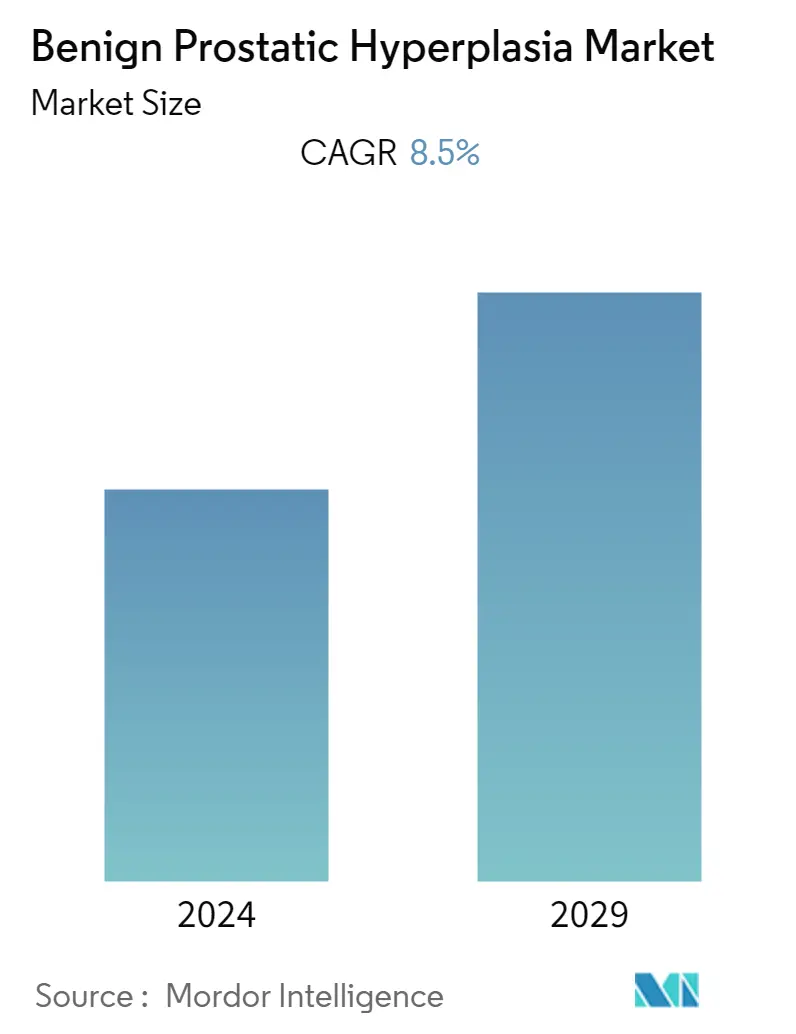
| Study Period | 2019 - 2029 |
| Base Year For Estimation | 2023 |
| Forecast Data Period | 2024 - 2029 |
| CAGR | 8.50 % |
| Fastest Growing Market | Asia Pacific |
| Largest Market | North America |
Major Players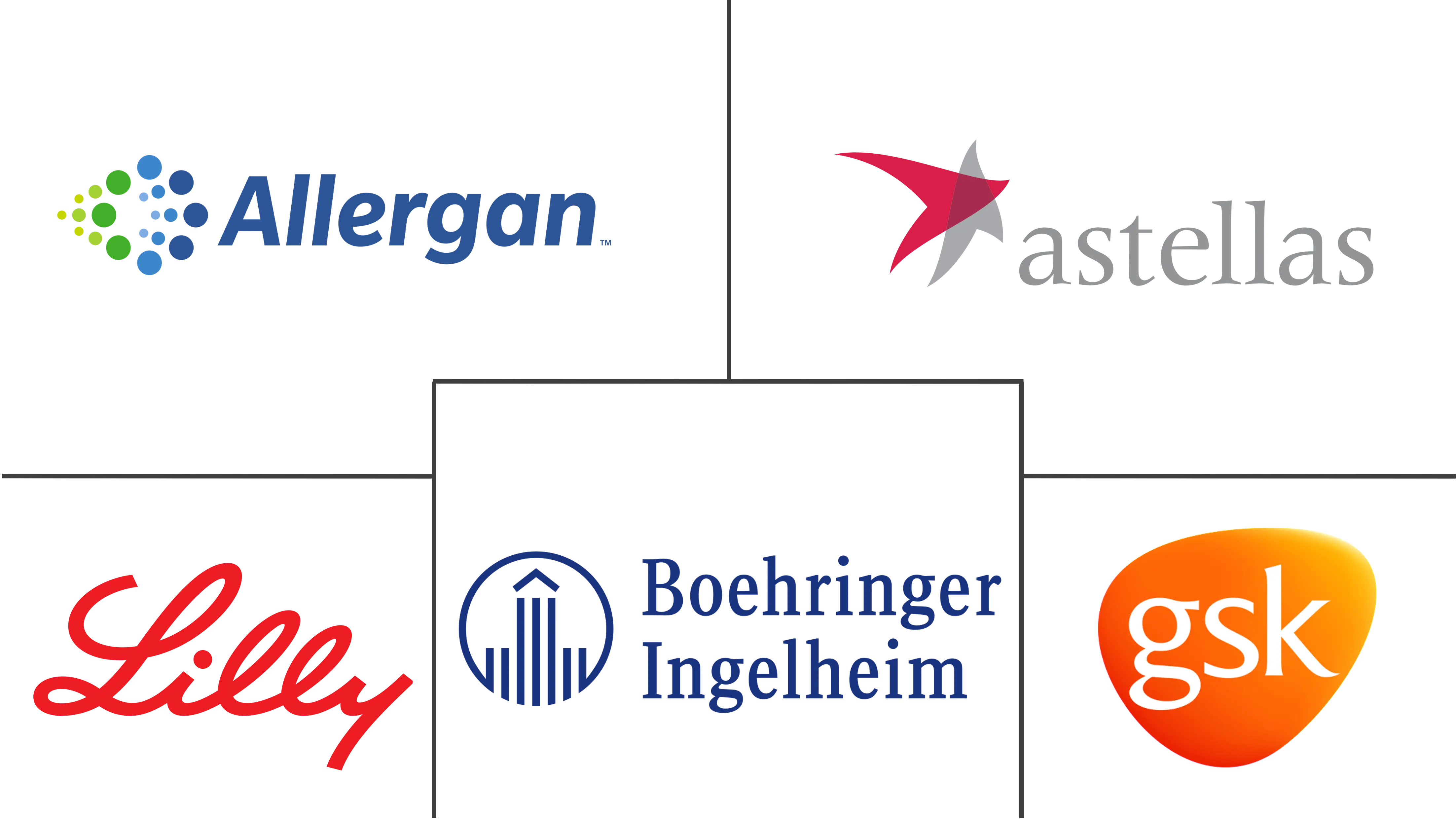
*Disclaimer: Major Players sorted in no particular order |
Benign Prostatic Hyperplasia Market Analysis
The benign prostatic hyperplasia market is expected to register a CAGR of nearly 8.5% during the forecast period (2022-2027). Benign prostatic hyperplasia (BPH) also known as benign prostatic hypertrophy is characterized by the unusual propagation of the prostatic cells, which causes difficulties, like urinary retention and infection of the urinary tract. It is most common among aging men.
According to the Union for International Cancer Control (UICC) in May 2020, there was a significant decrease in disease diagnostic rates in the United States during the COVID-19 pandemic. This had a significant impact on the market growth. However, such hindering impact on growth is anticipated to persist for a short duration. Moreover, according to the study titled 'Impact of the COVID-19 outbreak on prostate care in the Netherlands', published in the Cancer Treatment and Research Communications in January 2022, during the first COVID-19 wave, there was a 17% decrease in prostate cancer diagnoses. The reduction was most noticeable among the elderly and those with low-risk localized prostate conditions such as Benign Prostate Hyperplasia.
Benign prostatic hyperplasia (BPH) is being accepted as a growing health problem among elderly men. As per the 2022 data published by World Population Review, the average age of men is highest in Monaco i.e., 52 years as of 2022. The data suggests that the old men population is believed to increase rapidly over the coming years. With the rising population of aged men, the degree of the problem is projected to rise multifold over the next few years.
The geriatric population is expected to have a significant impact on the market studied as people aged above 65 are more prone to prostate cancer. According to the World Health Organization Facts of 2021, the proportion of the global population aged 60 and up will nearly double from 12% to 22% between 2015 and 2050. By 2050, 80% of the world's elderly will live in low and middle-income countries. The population is aging at a much faster rate than in the past. Every country faces significant challenges in ensuring that its health and social systems are prepared to take advantage of this demographic shift. According to the World Health Organization, in May 2020, by 2030, one out of every six people on the planet will be 60 years old or older. The number of people aged 60 and up is expected to rise from 1 billion in 2020 to 1.4 billion by 2050. By 2050, the global population of people aged 60 and above will double to reach 2.1 billion. Between 2020 and 2050, the number of people aged 80 and above is expected to triple, reaching 426 million. Benign prostate hyperplasia (BOH) is majorly associated with the age of a person and as the age increases, the chances of BPH increases. Hence, with a rise in geriatric population, the market studied is expected to witness strong growth in coming years.
Benign Prostatic Hyperplasia Market Trends
This section covers the major market trends shaping the Benign Prostatic Hyperplasia Market according to our research experts:
Alpha-Blockers Segment is Expected to Hold the Largest Share of Global Benign Prostatic Hyperplasia Market, Over the forecast period
Alpha-blockers help in relaxing the muscle of the prostate and the bladder neck, which allow urine to flow easier. Alpha-blockers work quickly and are usually the first line of treatment for men with mild to moderate symptoms. For instance, α1 blockers are recommended in the clinical guidelines for BPH in Japan, as first-line drug therapy for lower urinary tract symptoms (LUTS) associated with BPH. Moreover, for people with high blood pressure and BPH, alpha-blockers are the ideal treatment line for both conditions.
In February 2021, Veru Inc. announced that it had submitted a New Drug Application (NDA) with the United States Food and Drug Administration for TADFIN (tadalafil 5mg and finasteride 5mg) capsules, a novel oral daily dosing combination formulation, for the treatment of benign prostatic hyperplasia (BPH). Novel drugs such as Entadfi (finasteride and tadalafil) are also emerging in the market for the treatment of the signs and symptoms of benign prostatic hyperplasia (BPH) in men with an enlarged prostate for up to 26 weeks. The above-mentioned treatments for BPH contain alpha-blockers. With the emergence of such medications, the segment is expected to witness healthy growth over the forecast period.
Some of the commonly used alpha-blockers for benign prostatic hyperplasia include Cardura, Cardura XL, Minipress, Prazosin Hcl all manufactured by Pfizer, and Terazosin by CTX Lifesciences, Flomax by Boehringer Ingelheim, and Uroxatral by Ranbaxy Laboratories Ltd. As key pharmaceutical companies are in the business of manufacturing and marketing alpha-blockers for benign prostatic hyperplasia, the segment is believed to witness strong growth as key companies have better reach to patients across various countries.
Owing to these factors, alpha-blockers accounted for the largest market share in the global benign prostatic hyperplasia market.
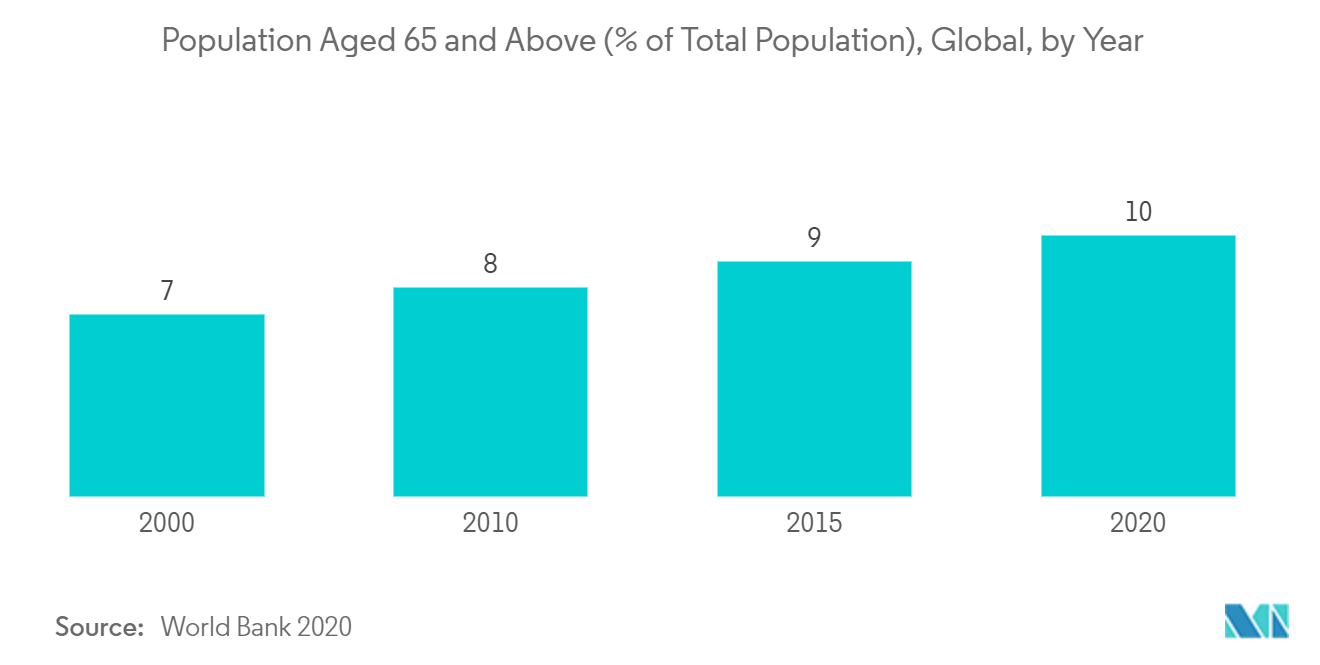
North America Region Holds the Largest Market Share of Benign Prostatic Hyperplasia Market
North America dominates the market owing to the high prevalence of BPH and other associated lower urinary tract symptoms. For instance, as per the data from the National Institute of Health, the prevalence of benign prostatic hyperplasia is as high as 50% to 60% for males in their 60's, increasing to 80% to 90% of those over 70 years of age.
In addition, several hospitals across the United States, and Canada have collaborated with non-profit organizations and companies such as GlaxoSmithKline in some of the projects to raise awareness and adequate resources for the treatment of urological disorders. Also, the rising geriatric population in the United States is contributing to market growth. For instance, as per the Administration for Community Living report published in 2021, in the year 2019, the population aged 65 and above was 54.1 million which is expected to increase to around 80.8 million by the year 2040.
As BPH is one of the risk factors associated with prostate cancer, there has been an increasing demand in the United States for early diagnosis and treatment of BPH. The rising number of prostate cancer cases is creating huge opportunities for market players. The major market players are focusing on research and development activities to bring new and reliable treatments to the market. For instance, in September 2021, the United States Food and Drug Administration authorized the marketing of software to assist medical professionals who examine body tissues (pathologists) in the detection of areas that are suspicious for cancer as an adjunct (supplement) to the review of digitally-scanned slide images from prostate biopsies (tissue removed from the body). Such initiatives will lead to increased adoption of prostate examinations and treatment in the United States, thereby driving the market growth.
Therefore, owing to the above-mentioned factors, the United States is expected to witness a significant share in the market studied.
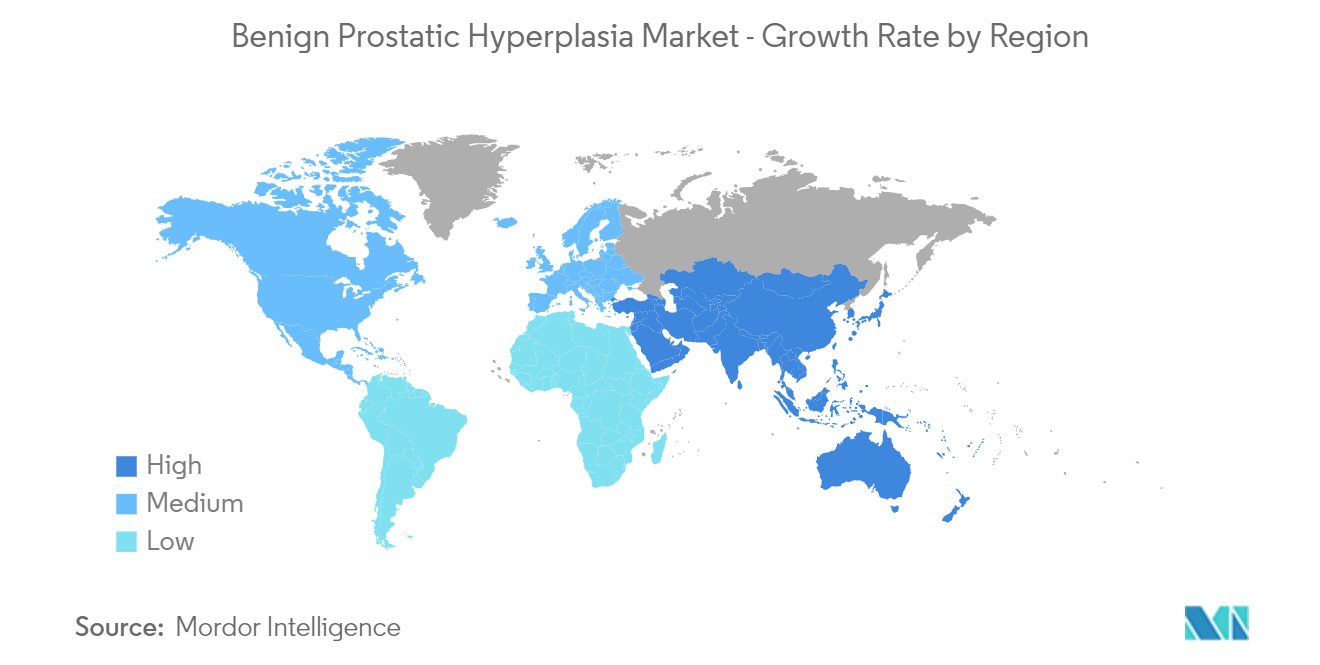
Benign Prostatic Hyperplasia Industry Overview
Key players that are expected to be dominant in Benign Prostatic Hyperplasia market are Allergan PLC, Eli Lilly & Company, Boehringer Ingelheim, Merck & Co. Inc., and Astellas Pharma Inc. The companies are implementing certain strategic initiatives, such as a merger, new product launch, acquisition, and partnerships that help them in strengthening their market position.
Benign Prostatic Hyperplasia Market Leaders
-
Allergan PLC
-
Eli Lilly and Company
-
Merck & Co., Inc.
-
Boehringer Ingelheim
-
Astellas Pharma Inc.
*Disclaimer: Major Players sorted in no particular order
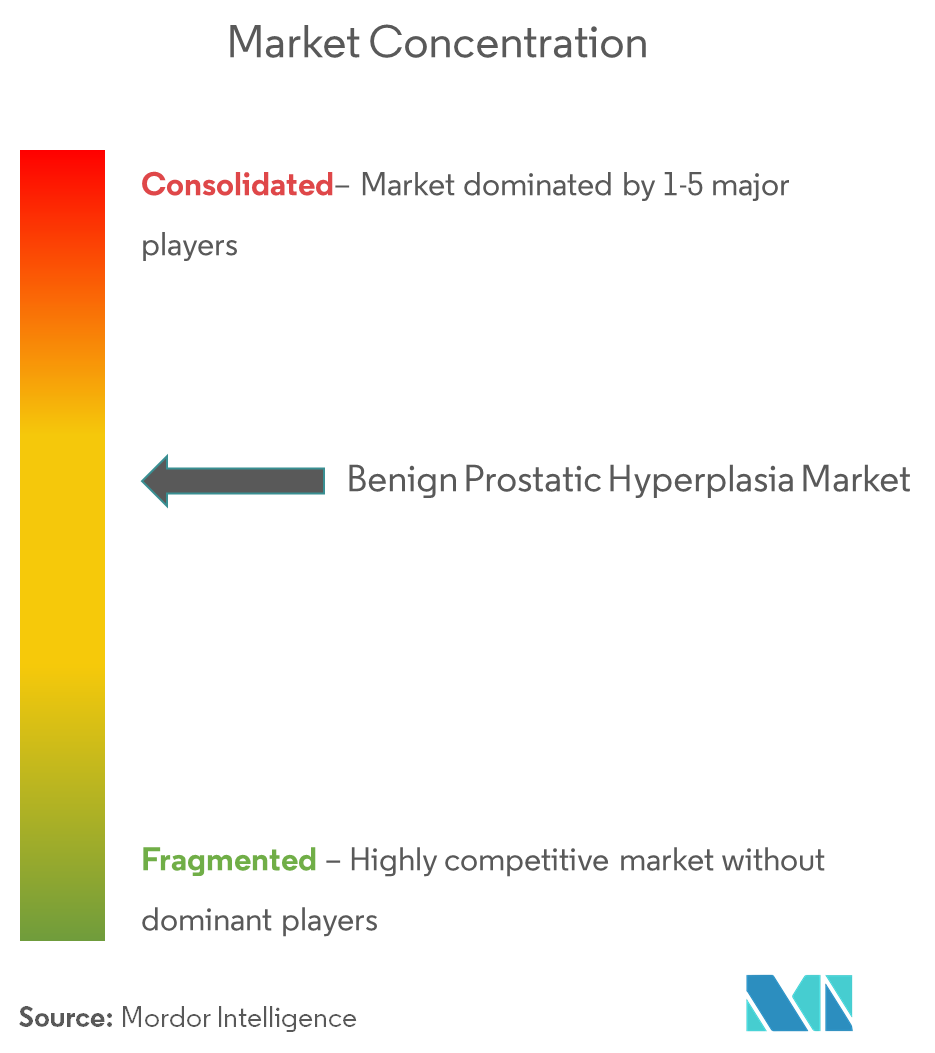
Benign Prostatic Hyperplasia Market News
- In June 2022, Astellas Pharma Inc. and GO Therapeutics, Inc. announced that Xyphos Biosciences, Inc., (a wholly owned subsidiary of Astellas) and GO have entered into a strategic research collaboration and license agreement to develop novel Immuno-Oncology therapeutics.
- In December 2021, Veru announced FDA Approval of ENTADFI, a new treatment for Benign Prostatic Hyperplasia.
Benign Prostatic Hyperplasia Market Report - Table of Contents
1. INTRODUCTION
- 1.1 Study Assumptions and Market Definition
- 1.2 Scope of the Study
2. RESEARCH METHODOLOGY
3. EXECUTIVE SUMMARY
4. MARKET DYNAMICS
- 4.1 Market Overview
-
4.2 Market Drivers
- 4.2.1 Rising Geriatric Population
- 4.2.2 Growing Technological Advancements in Personalized Medicines
-
4.3 Market Restraints
- 4.3.1 Rising Preference Toward Minimally Invasive Surgeries
- 4.3.2 Non-adherence of Patients to Pharmacological Therapy
-
4.4 Porter's Five Force Analysis
- 4.4.1 Threat of New Entrants
- 4.4.2 Bargaining Power of Buyers/Consumers
- 4.4.3 Bargaining Power of Suppliers
- 4.4.4 Threat of Substitute Products
- 4.4.5 Intensity of Competitive Rivalry
5. MARKET SEGMENTATION
-
5.1 By Drug Type
- 5.1.1 Alpha-Blockers
- 5.1.2 5- Alpha-Reductase Inhibitors (5-Aris)
- 5.1.3 Alpha-Adrenergic Blockers
- 5.1.4 Phosphodiesterase-5 Enzyme Inhibitors
- 5.1.5 Other Drug Types
-
5.2 By Distribution Channel
- 5.2.1 Hospital Pharmacies
- 5.2.2 Retail Pharmacies
- 5.2.3 Online Pharmacies
-
5.3 Geography
- 5.3.1 North America
- 5.3.1.1 United States
- 5.3.1.2 Canada
- 5.3.1.3 Mexico
- 5.3.2 Europe
- 5.3.2.1 Germany
- 5.3.2.2 United Kingdom
- 5.3.2.3 France
- 5.3.2.4 Italy
- 5.3.2.5 Spain
- 5.3.2.6 Rest of Europe
- 5.3.3 Asia Pacific
- 5.3.3.1 China
- 5.3.3.2 Japan
- 5.3.3.3 India
- 5.3.3.4 Australia
- 5.3.3.5 South Korea
- 5.3.3.6 Rest of Asia-Pacific
- 5.3.4 Middle East and Africa
- 5.3.4.1 GCC
- 5.3.4.2 South Africa
- 5.3.4.3 Rest of Middle East and Africa
- 5.3.5 South America
- 5.3.5.1 Brazil
- 5.3.5.2 Argentina
- 5.3.5.3 Rest of South America
6. COMPETITIVE LANDSCAPE
-
6.1 Company Profiles
- 6.1.1 Allergan PLC
- 6.1.2 Astellas Pharma Inc.
- 6.1.3 Boehringer Ingelheim
- 6.1.4 Eli Lilly and Company
- 6.1.5 GlaxoSmithKline PLC
- 6.1.6 Nymox Pharmaceutical Corporation
- 6.1.7 Pfizer Inc
- 6.1.8 Sanofi
- 6.1.9 Sophiris Bio Corp
- 6.1.10 Teva Pharmaceutical Industries Limited
- *List Not Exhaustive
7. MARKET OPPORTUNITIES AND FUTURE TRENDS
** Subject To AvailablityBenign Prostatic Hyperplasia Industry Segmentation
As per the scope of the report, benign prostatic hyperplasia is a medical condition involving enlargement of the prostate gland and it is highly prevalent in males. It is a non-cancerous growth of the prostate gland originating from the uncontrolled expansion of prostate cells. The Benign Prostatic Hyperplasia Market is segmented by Drug Type (Alpha-Blockers, 5- Alpha-Reductase Inhibitors (5-Aris), Alpha-Adrenergic Blockers, Phosphodiesterase-5 Enzyme Inhibitors, and Other Drug Types), Distribution Channels (Hospital Pharmacies, Retail Pharmacies, Online Pharmacies), and Geography (North America, Europe, Asia-Pacific, Middle East, and Africa, and South America). The market report also covers the estimated market sizes and trends for 17 different countries across major regions, globally. The report offers the value (in USD million) for the above segments.
| By Drug Type | Alpha-Blockers | |
| 5- Alpha-Reductase Inhibitors (5-Aris) | ||
| Alpha-Adrenergic Blockers | ||
| Phosphodiesterase-5 Enzyme Inhibitors | ||
| Other Drug Types | ||
| By Distribution Channel | Hospital Pharmacies | |
| Retail Pharmacies | ||
| Online Pharmacies | ||
| Geography | North America | United States |
| Canada | ||
| Mexico | ||
| Geography | Europe | Germany |
| United Kingdom | ||
| France | ||
| Italy | ||
| Spain | ||
| Rest of Europe | ||
| Geography | Asia Pacific | China |
| Japan | ||
| India | ||
| Australia | ||
| South Korea | ||
| Rest of Asia-Pacific | ||
| Geography | Middle East and Africa | GCC |
| South Africa | ||
| Rest of Middle East and Africa | ||
| Geography | South America | Brazil |
| Argentina | ||
| Rest of South America |
Benign Prostatic Hyperplasia Market Research FAQs
What is the current Benign Prostatic Hyperplasia Market size?
The Benign Prostatic Hyperplasia Market is projected to register a CAGR of 8.5% during the forecast period (2024-2029)
Who are the key players in Benign Prostatic Hyperplasia Market?
Allergan PLC, Eli Lilly and Company, Merck & Co., Inc., Boehringer Ingelheim and Astellas Pharma Inc. are the major companies operating in the Benign Prostatic Hyperplasia Market.
Which is the fastest growing region in Benign Prostatic Hyperplasia Market?
Asia Pacific is estimated to grow at the highest CAGR over the forecast period (2024-2029).
Which region has the biggest share in Benign Prostatic Hyperplasia Market?
In 2024, the North America accounts for the largest market share in Benign Prostatic Hyperplasia Market.
What years does this Benign Prostatic Hyperplasia Market cover?
The report covers the Benign Prostatic Hyperplasia Market historical market size for years: 2019, 2020, 2021, 2022 and 2023. The report also forecasts the Benign Prostatic Hyperplasia Market size for years: 2024, 2025, 2026, 2027, 2028 and 2029.
Benign Prostatic Hyperplasia Industry Report
Statistics for the 2024 Benign Prostatic Hyperplasia market share, size and revenue growth rate, created by Mordor Intelligence™ Industry Reports. Benign Prostatic Hyperplasia analysis includes a market forecast outlook to 2029 and historical overview. Get a sample of this industry analysis as a free report PDF download.



